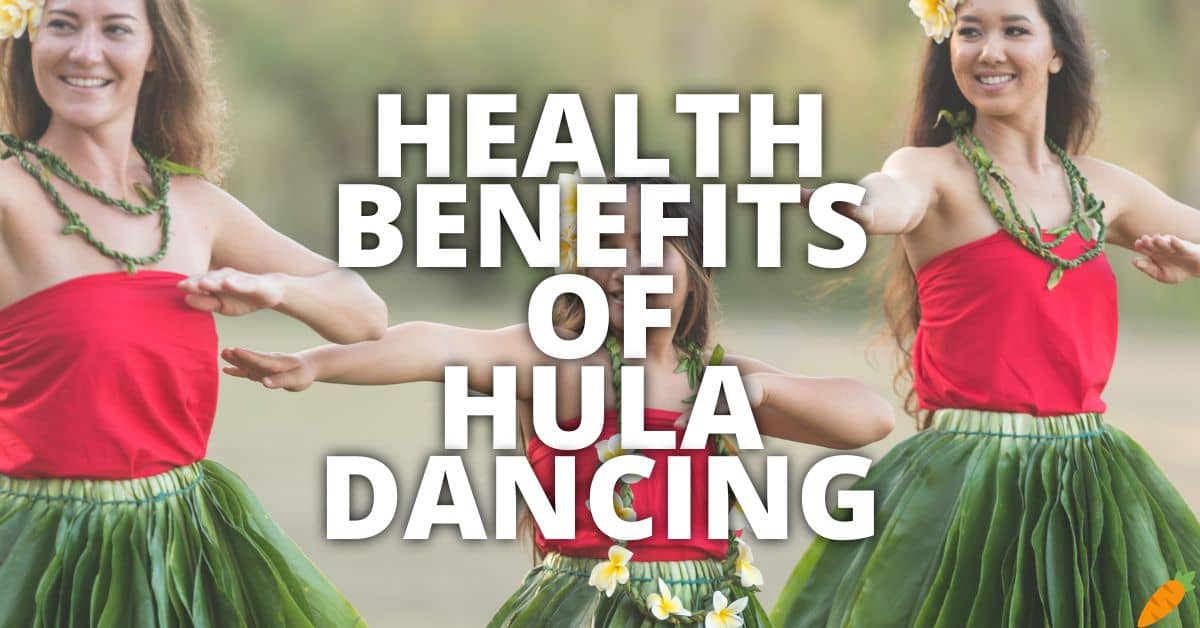It’s an excellent day to review the potential health benefits of hula dancing.
🤔 What is hula dancing?
Hula dancing is a traditional Polynesian dance form originating in Hawaii.
It involves rhythmic movements of the body, especially the hips, hands, and feet, often accompanied by chants or songs.
Hula serves not just as entertainment but also as a means of telling stories, preserving histories, and expressing emotions.
There are two main types: Auana, a contemporary style with Western influences and songs with Western melodies, and Kahiko, an ancient style with traditional instruments and chants.
The dancers typically wear grass skirts, leis, and other traditional clothing, and there are frequently instruments like the ukulele, drums, and gourd rattles in the background.
📝 Here’s a list of the potential health benefits of hula dancing:
- Cardiac Health
- Muscle Fortification
- Greater Limberness
- Weight Regulation
- Better Equilibrium And Precision
- Cognitive Concentration
- Cultural Bonding
- Relief From Stress
- Communal Engagement
- Emotional Articulation
- Boosted Confidence
Please continue reading if you want to learn more.
1. Cardiovascular Fitness
Cardiovascular fitness is a pivotal component of overall health, and hula dancing offers a fun and effective way to enhance it.
As dancers engage in the rhythmic and flowing motions of hula, their heart rate naturally increases.
This sustained elevation in heart rate promotes better blood circulation, ensuring that vital organs receive adequate oxygen.
Over time, consistent hula dancing can strengthen the heart muscles, reducing the risk of heart-related ailments.
Thus, beyond its cultural significance, hula offers a dynamic cardio workout beneficial for heart health.
2. Strengthens Muscles
Muscle strength is integral to maintaining daily functionality and preventing injuries.
Hula dancing, with its characteristic hip sways and leg motions, targets multiple muscle groups simultaneously.
Specifically, the dance intensely engages the legs, core, and glutes, leading to improved muscle tone and endurance.
The consistent shifting of weight and posture adjustment required in hula provides a comprehensive workout, akin to resistance training.
As a result, regular participation in hula dancing not only enhances aesthetics but also bolsters the body’s muscular foundation.
3. Improved Flexibility
Flexibility is crucial for overall mobility and injury prevention.
Hula dancing, with its graceful and fluid movements, naturally stretches and exercises the body’s joints and muscles.
The emphasis on hip rotations and lower body motions offers a unique opportunity to enhance flexibility in those areas.
As dancers consistently practice and refine their hula techniques, the range of motion in their hips, thighs, and calves expands.
Consequently, integrating hula into one’s routine can lead to increased agility and reduced susceptibility to strains and muscle injuries.
4. Weight Management
Managing one’s weight is vital for overall health and can mitigate risks associated with various ailments.
Hula dancing, as a dynamic and engaging activity, serves as an effective calorie-burning exercise.
The combined efforts of footwork, hip motions, and arm movements mean that dancers are constantly active, leading to higher energy expenditure.
As participants increase their intensity and frequency of hula sessions, they can achieve a substantial calorie burn.
Thus, hula dancing not only provides cultural enrichment but also offers a practical solution for those seeking an enjoyable weight management activity.
5. Enhanced Balance And Coordination
Balance and coordination are foundational skills that aid in daily tasks and prevent falls or mishaps.
Hula dancing, with its intricate combination of foot and hand choreography, challenges dancers to maintain stability while executing precise movements.
This continuous interplay between various body parts sharpens the dancer’s proprioception, or sense of body position in space.
As dancers regularly practice hula, they develop enhanced muscle memory, leading to smoother, more coordinated movements.
Ultimately, mastering the nuances of hula dancing can significantly bolster an individual’s balance and coordination, benefiting their overall physical prowess.
📙 Aqua Zumba may also improve balance and coordination. This page contains more information about its health benefits.
6. Mental Focus
Cognitive agility and focus are vital for both daily tasks and long-term mental health.
Hula dancing, with its detailed choreography, demands dancers recall specific steps and sequences, challenging the brain much like a puzzle would.
This requirement for memory recall and pattern recognition exercises the brain, fostering neural connectivity.
As dancers consistently engage in hula, they not only sharpen their dancing skills but also hone their cognitive abilities, enhancing memory and focus.
Through this cerebral workout, hula dancing offers a potent blend of physical and mental enrichment.
7. Cultural Connection
Cultural appreciation forms the bedrock of diverse and inclusive societies.
Hula dancing serves as a vivid gateway into the rich tapestry of Hawaiian history and traditions.
By engaging in this dance, participants immerse themselves in the stories, values, and rhythms of the Hawaiian people.
This cultural immersion not only deepens one’s appreciation for Hawaii’s unique heritage but also fosters a sense of global belonging.
Through hula, individuals can bridge cultural gaps, cultivating empathy and understanding for a world beyond their immediate surroundings.
8. Stress Reduction (My Favorite Potential Health Benefit Of Hula Dancing)
In today’s fast-paced world, finding effective stress-relief techniques is paramount for mental well-being.
Hula dancing, with its rhythmic movements synchronized to mellifluous tunes, offers a therapeutic escape.
The combination of fluid dance steps and harmonious music envelops the dancer, creating a trance-like state that is akin to meditation.
This immersive experience allows individuals to momentarily detach from their daily worries, promoting relaxation and mental clarity.
Thus, hula dancing serves not only as a cultural expression but also as a potent tool for mental rejuvenation and stress relief.
9. Social Interaction
Human beings are inherently social creatures, and meaningful connections play a pivotal role in emotional well-being.
Hula dancing, often practiced in groups or classes, creates a communal space where individuals converge around a shared interest.
This environment fosters interaction, collaboration, and camaraderie among participants.
By regularly engaging with peers in such settings, individuals can forge new friendships and strengthen existing bonds.
Consequently, hula dancing not only preserves cultural traditions but also nurtures a sense of community, reducing feelings of loneliness and isolation.
📚 Dance Ethnology And The Anthropology Of Dance
10. Emotional Expression
Art forms have historically served as platforms for emotional catharsis and communication.
Hula dancing, deeply rooted in Hawaiian tradition, is more than just coordinated movement; it’s a narrative art.
Through the dance’s intricate gestures and postures, dancers convey stories laden with emotions, be they joy, sorrow, love, or conflict.
This act of storytelling allows dancers to channel their feelings, offering both an introspective journey and a shared emotional experience with the audience.
Hula, therefore, becomes a bridge, translating individual emotions into universal tales that resonate across cultures and epochs.
📙 Emotional expression may also be encouraged through line dancing. More information about its health benefits can be found on this page.
11. Increased Self-Esteem
Self-esteem is a cornerstone of mental well-being, influencing how individuals perceive themselves and their capabilities.
Engaging in hula dancing presents challenges, requiring learners to grasp complex techniques and movements.
As individuals progress and refine their skills, they experience tangible growth in their dancing proficiency.
This palpable improvement instills a sense of accomplishment, reinforcing one’s belief in one’s abilities.
Consequently, the journey from novice to adept in hula can bolster self-esteem, fostering confidence and a heightened sense of self-value.
💡 Conclusion
While many associate hula dancing with vibrant Hawaiian festivities, its benefits stretch far beyond cultural celebrations.
Hula is a comprehensive workout, offering cardiovascular enhancement, muscle strengthening, and increased flexibility.
It’s a dance that engages not just the body but the mind, with cognitive challenges promoting mental agility and focus.
Socially, hula fosters community ties, reducing feelings of isolation.
Emotionally, it’s a profound means of expression, storytelling, and boosting self-esteem.
All in all, hula dancing is a beautiful synthesis of culture and well-being, proving that traditions can serve both soul and body in equal measure.
So, the next time you think of hula, remember that it’s not just a dance; it’s a holistic journey towards better health.
😊 My favorite potential health benefit of hula dancing is that it may help reduce stress.
This kind of dancing seems to be an easy way to relieve stress, especially for someone like me who doesn’t have a talent for this art.
In this new world, stress has become a serious thing.
What’s your favorite potential health benefit of hula dancing?
Please share this post with your family and friends if you find it helpful.
I appreciate it!
Be healthy 💪 and stay safe 🦺!
⛑️ Safety First
While hula dancing offers numerous potential health benefits, it’s essential to approach it with caution, especially for individuals with certain medical conditions or physical restrictions.
Not everyone may be suited for the dance’s demands.
Before beginning any hula training, it’s recommended to consult with a doctor or medical professional to ensure it’s a safe activity for you.
It’s important to note that while many health benefits are associated with hula dancing, some may be based on anecdotal evidence.
Therefore, conducting personal research and seeking guidance from professionals in both the medical and dance fields is essential to making informed decisions.
Always prioritize safety and personal well-being above all.
📋 Summary
| Potential Health Benefits Of Hula Dancing | Details |
| Cardiovascular Fitness | Continuous movement elevates the heart rate, promoting better blood circulation and heart health. |
| Strengthens Muscles | The dance’s repetitive hip and leg movements engage and tone the core, legs, and glutes. |
| Improved Flexibility | Its flowing movements naturally stretch and exercise joints and muscles, especially in the hips and lower body. |
| Weight Management | Engaging in this dynamic activity leads to calorie burning, which assists in weight regulation. |
| Enhanced Balance And Coordination | The dance demands precise footwork and hand movements in tandem, honing balance and precision. |
| Mental Focus | The requirement to remember specific steps and sequences can sharpen cognitive function and concentration. |
| Cultural Connection | This dance provides a deep dive into Hawaiian traditions, fostering a greater appreciation for and connection to its culture. |
| Stress Reduction | The rhythmic motions and accompanying music create a meditative environment, alleviating stress and anxiety. |
| Social Interaction | Participating in group sessions or classes promotes community engagement and camaraderie. |
| Emotional Expression | Beyond its physical movements, it’s a medium of storytelling, enabling dancers to convey emotions and narratives. |
| Increased Self-Esteem | Mastering its intricate techniques fosters a sense of achievement, boosting confidence and self-worth. |
⚠️ Content Disclaimer
The information provided in this content is intended for general informational purposes only.
It should not be construed as professional advice or guidance.
Readers are encouraged to consult with relevant professionals or conduct their own research before making any decisions based on this content.
The author and publisher disclaim any responsibility for any adverse effects or consequences arising from the use or reliance on the information herein.

